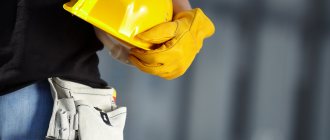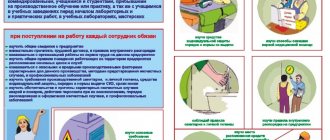Let's turn to the legislation
Let's consider what legislative acts regulate occupational safety instructions in the workplace:
- Art. 212 of the Labor Code of the Russian Federation states that the employer is obliged to ensure the development and approval of rules and instructions on occupational safety for employees, taking into account the opinion of the trade union;
- The procedure for developing and approving IOT for employees is specified in the Methodological Recommendations for the development of state regulatory requirements for labor protection, approved. Resolution of the Ministry of Labor of the Russian Federation dated December 17, 2002 No. 80;
- instructions for the development of IOT are contained in Letter of the Ministry of Labor of Russia dated March 3, 2017 No. 15-2/OOG-546.
OCCUPATIONAL SAFETY REQUIREMENTS BEFORE STARTING WORK
2.1. Check the serviceability of work clothes, safety shoes and other personal protective equipment for the absence of external damage. Overalls must be of the appropriate size, clean and not restrict movement. 2.2. Wear protective clothing and personal protective equipment appropriate for the work being performed. Overalls must be fastened, and dangling ends are not allowed. Tuck your hair under your headdress. It is prohibited to pin protective clothing with pins or needles, or to keep sharp or breakable objects in your pockets. 2.3. Receive an assignment from your immediate supervisor to perform the work, if necessary, obtain a work permit and undergo training. 2.4. Establish the sequence of operations. 2.5. Select the equipment, tools and devices necessary to perform the work, check their compliance with safety requirements, and arrange them in an order convenient for work. 2.6. When carrying out work on the roadway, install the necessary protective barriers and warning posters. 2.7. Check the lighting condition of the workplace, check the operation of ventilation. 2.8. Prepare the workplace for safe work: - inspect it, remove all unnecessary objects without blocking the passages; — check approaches to the workplace and evacuation routes for compliance with labor protection requirements; — check the availability of fire fighting equipment and a first aid kit. 2.9. Check the availability, completeness and condition of tools, materials, protective equipment, signs, fences. 2.10. Ensure that the work site is fenced and warning and instructive posters (signs) are posted. 2.11. When performing work at height, the technician must use a protective helmet with a fastened chin strap. The internal equipment and chin strap must be removable and have devices for attachment to the helmet body. The chin strap must be adjustable in length, the method of fastening must allow it to be quickly detached and prevent the helmet from spontaneously falling or moving from the worker’s head. 2.12. Without the required PPE or with faulty PPE, technicians are not allowed to work at height. 2.13. Containers emptied of solvents and paints and varnishes should be immediately removed from the workplace to the storage area. 2.14. A paint solution accidentally spilled on the floor must be immediately covered with dry sand or sawdust and then removed. 2.15. Check the serviceability of the hand tool and make sure that it meets the following safety requirements: - the heads of hammers and sledgehammers have a smooth, slightly convex surface without bevels, chips, gouges, cracks and burrs; — the handles of hammers, sledgehammers and other impact tools are made of dry hardwood without knots or cross-layers or from synthetic materials that ensure operational strength and reliability in operation. The handles are smooth, without cracks, and have an oval cross-section along their entire length; - the handle is somewhat thickened towards the free end to prevent it from slipping out of the hand when swinging and striking with the instrument. For sledgehammers, the handle towards the free end should be somewhat thinner; the sledgehammer is placed on the handle towards the thickened end, without wedges; - the axis of the handle is perpendicular to the axis of the hammer or sledgehammer. The wedges for securing the hammer are made of mild steel and have notches (ruffs); — the handles of files, scrapers, hacksaws are tightened with metal bandage rings; — the screwdrivers have serviceable handles, a straight shaft, the working part has smooth, flat side edges, without chips or damage; — percussion tools (chisels, crosscutters, bits, notches, cores, etc.) are smooth, the back part is free of cracks, burrs, hardening and chips. There is no damage to the working part, the length of the tool is at least 150 mm. The middle part of the chisel has an oval or multifaceted cross-section without sharp edges and burrs on the side edges, the striking part has the shape of a truncated cone; — the working surfaces of the wrenches do not have cracks, nicks, bevels, and the handles do not have burrs; — hand lever scissors are securely fastened to a special stand, no dents, damage or cracks are allowed in any part of the knives, the cutting edges of the knives are sharp and touch tightly. 2.16. It is prohibited to work with faulty tools and accessories or on faulty equipment. 2.17. When working in wells, receive safety systems, gas analyzers, a 12-volt battery flashlight, a hand fan, fences, standard posters, hooks and crowbars for opening well covers and hatches, buckets, and tools. All equipment received for work must be checked to ensure that it is in good working order. 2.18. Install the necessary fences, warning posters and road signs near open wells and pits. At night, hang lights with red lenses on signal posts. 2.19. Check the serviceability of the brackets or ladder in the well, 6-8 hours before starting work, open the manhole covers of two adjacent ones and the working well to ventilate them. 2.20. Check for warning signs. 2.21. All insulating parts of the tool must have a smooth surface, no cracks or burrs. The insulating coating of the handles must fit tightly to the metal parts of the tool and completely insulate the part that is in the operator’s hand during operation. Insulated handles must be equipped with stops and have a length of at least 10 cm. 2.22. Before performing work near electrical installations or moving parts of production equipment, make sure that protective fences are installed in dangerous places or electrical installations are turned off, the equipment is stopped and disconnected from the network, and “Do not turn on!” posters are posted on disconnecting devices. People are working! 2.23. Unauthorized work is not allowed, as well as expansion of the workplace and scope of the task. 2.24. The technician must personally verify that all necessary safety measures have been implemented. 2.25. Report all detected malfunctions and malfunctions to your immediate supervisor and begin work only after they have been eliminated.
What kind of document is this
The Occupational Safety Instruction (OSI) is a local regulatory act that establishes specific responsibilities of an organization’s employees to comply with safe work requirements. There are several types of instructions:
- by position. For example, instructions for a teacher or a cook;
- when performing specific work. For example, instructions on labor safety when performing excavation work;
- which contain rules of conduct for personnel in the event of an emergency. For example, occupational safety instructions for anti-terrorist safety or in case of fire.
The requirements are mandatory, and failure to comply with them is equivalent to a violation of labor discipline.
What is important to understand when developing a job description: occupational health and safety is not limited to the presence of individual IOT. The employer is obliged to organize and conduct occupational safety training for its staff - this is indicated in Art. 225 Labor Code of the Russian Federation.
OCCUPATIONAL SAFETY REQUIREMENTS AFTER WORK COMPLETION
5.1. Turn off the equipment, disconnect from the power supply and put it in order. 5.2. Inspect and tidy up the workplace. Remove materials, fences, and debris. 5.3. Collect used cleaning material in metal boxes with a tight-fitting lid. 5.4. Inspect tools, equipment and accessories, put them in order and put them in the places designated for their storage. 5.5. Take off workwear, safety shoes and other personal protective equipment, inspect, put in order and put in the designated storage place, if necessary, hand in for washing and/or repair. 5.1. Wash your hands and face with warm water and soap, and take a shower. 5.2. Inform your supervisor about all violations and comments identified during the work process and the measures taken to eliminate them.
Development order
OSH manuals (for example, occupational safety instructions for the security service or any other) are developed in the following order:
- the employer issues an order and draws up a list of professions and types of work for which IOT is required;
- the list is approved by the employer;
- department heads develop IOT projects;
- projects are coordinated with the trade union or other authorized body of workers in the manner specified in Art. 372 of the Labor Code of the Russian Federation for the adoption of local regulations;
- after agreement, they are approved by the head of the organization. The title page indicates the name of the organization, date, information about the persons who approved the document;
- Employees, upon signature, familiarize themselves with the documents they need on occupational safety (including when hiring, transferring, briefings, making changes or introducing new ones);
- information about the rules is entered into a special IOT accounting journal (more details about the journal can be found in Letter of the Ministry of Labor of Russia dated September 15, 2016 No. 15-2/OOG-3318).
When developing documents, you should consider:
- requirements contained in interindustry or industry standard guidelines for occupational safety;
- requirements for safe operation set out in the operation and repair manuals of equipment manufacturers and in the technological documentation of the enterprise, taking into account specific production conditions;
- materials of accidents that occurred at the enterprise, in order to avoid their recurrence.
OCCUPATIONAL SAFETY REQUIREMENTS DURING WORK
3.1. Submit to internal labor regulations and other documents regulating labor discipline issues. 3.2. Comply with sanitary and hygienic requirements. 3.3. Correctly use workwear, safety shoes and other personal protective equipment. 3.4. Do not allow untrained or unauthorized persons to perform your work. The presence of unauthorized persons in the working space of the shot blasting unit during work is not allowed. 3.5. While working, you should be attentive, not be distracted from performing your duties and not distract other workers. 3.6. A technician who is ill or overworked, or under the influence of alcohol, drugs or medications that dull attention and reaction, should not begin work, as this may lead to an accident. 3.7. During work, you need to behave calmly and with restraint, avoid conflict situations that can cause nervous and emotional tension and affect work safety. 3.8. Comply with the safety requirements set out in the operating instructions for the equipment and tools used. 3.9. Comply with the requirements ensuring safe working conditions and normal operation of the technological process. 3.10. All repair work must be carried out only after a power outage. 3.11. The technician is prohibited from: - installing and removing the plug with wet hands; - pull and twist the power cord; — independently open and repair equipment and tools; — carry out work without using the necessary PPE; — leave switched on equipment and tools unattended; — use faulty equipment and tools; — use compressed air to clean workwear, pointing the hose at yourself or others. 3.12. It is not allowed to perform work at height: - in open places with an air flow (wind) speed of 15 m/s or more; — in case of a thunderstorm or fog, excluding visibility within the work front, as well as in case of ice from icy structures and in cases of ice wall growth on wires, equipment, engineering structures (including power line supports), trees; — when installing (dismantling) structures with a large windage at a wind speed of 10 m/s or more. 3.13. Materials, products, structures when receiving and storing at workplaces located at height must be accepted in the volumes necessary for current processing, and stacked so as not to block the workplace and passages to it based on the load-bearing capacity of scaffolding, scaffolding, platforms, on which the specified cargo is placed. 3.14. The handles of the tools used must be made of wood, smoothly processed, adjusted and securely fastened. 3.15. It is prohibited to use hand tools that have dents, chipped working ends, burrs and sharp ribs in places where the hand is clamped, or cracks and chips on the back of the head. 3.16. In premises for the preparation of compositions for painting work, as well as in places where nitro paints, paints and varnishes and other compositions that form explosive and fire-hazardous vapors are used, it is prohibited to use open fire and bring in non-explosion-proof lamps. 3.17. After use, place the cleaning material in metal boxes with lids and, at the end of the shift, remove them from the production premises to places specially designated for this purpose. Do not leave dirty cleaning material in production areas after work. 3.18. When transporting garbage and waste manually, do not exceed the norms for carrying heavy loads. 3.19. Take special care when cleaning around hatches, slopes, stairs and doors. 3.20. During work, do not interfere with the movement of vehicles. 3.21. Do not stand in front or behind a skidding vehicle. 3.22. Remove garbage, waste, glass only with gloves, and do not compact garbage in buckets and other containers. While working on the territory, do not leave waste on the roadway or pedestrian paths, but collect it and take it to a specially designated place. 3.23. When cleaning the area, it is prohibited to touch live parts, conductors and broken wires with your body or cleaning equipment. 3.24. If you find a broken wire on an active power line lying on the ground, you must immediately notify your supervisor. It is prohibited to approach the wire at a distance of less than 8 m. 3.25. It is prohibited to sweep garbage and waste into hatches, openings, channels and wells. 3.26. During work, it is prohibited to stand on any kind of underground and above-ground pipelines, as well as on electrical cables, heating radiators and ventilation ducts, walk on them or lean on them when pulling up and descending from one height to another. 3.27. Working from portable ladders is allowed at a height of no more than 1.3 m from the ground or floor. 3.28. Portable ladders must have devices that prevent the possibility of shifting and tipping during operation. The lower ends of portable ladders must have fittings with sharp tips, and when used on asphalt, concrete and similar floors, they must have shoes made of rubber or other non-slip material. If necessary, the upper ends of ladders must have special hooks. 3.29. When using ladders and stepladders, it is prohibited to: - work on unsupported structures and walk on them, as well as climb over fences; - work on the top two steps of the stairs; - two workers should be on the ladder or on one side of the step ladder; — move up the stairs with a load or with a tool in hand; - use stairs with steps sewn with nails; - work on a faulty ladder or steps; — increase the length of stairs, regardless of the material from which they are made; - stand or work under stairs. 3.30. In order to protect against accidents in the event of accidental falls of any objects, tools, etc. areas dangerous for people must be fenced off, have clearly visible warning signs and be guarded by specially designated workers. 3.31. Before using new electrified tools and equipment, the technician must first familiarize himself with the operating instructions and safety precautions in detail. 3.32. Working with electrified tools from ladders is not allowed. Work must be carried out from scaffolding or scaffolding, which must be fenced with railings at least 1 m high and a side board at least 15 cm high. 3.33. When transporting an electrified tool to another place and during breaks in work, it should be disconnected from the power source. 3.34. Working with power tools during rain and snow is allowed in open areas only if there are canopies at the workplace and with the mandatory use of dielectric gloves, galoshes, and mats. 3.35. Crowbars, shovels, axes, scarpels, saws, chisels, chisels, bolts and other tools must be well sharpened. Saws and bolts must have an appropriate tooth pattern. 3.36. Hand saws, shovels, axes, sledgehammers, and hammers must be tightly mounted on strong handles. The handles of axes, sledgehammers, and hammers must be made of hardwood and secured with steel wedges. The surface of the handles must be completely smooth, without ribs, corners, burrs or other irregularities. The handles of sledgehammers and hammers should have a thickening towards the free end. 3.37. Carry the tool to the workplace only in a special bag or box. When working in wells, chambers, tanks at water supply and sewerage facilities, use safety safety systems. 3.38. When working in wells and other underground communications where explosive gases may accumulate, it is allowed to use battery-powered flashlights with a voltage of no higher than 6 W for lighting. 3.39. If gas is detected in the well, it should be removed. After the gas has been removed, work in the well is permitted only with constant air injection by a fan. 3.40. To remove gas, the following should be used: - natural ventilation by opening the lid of the working well and two adjacent (above and below) inspection wells; — air injection using a manual fan or blowers installed on special vehicles; — filling with water from a fire hydrant located in a water well with subsequent pumping. 3.41. Do not clutter the workplace, passages and driveways to it, passages between equipment, racks, passages to control panels, switches, evacuation routes and other passages with empty containers, equipment, etc. 3.42. Work on the preparation of painting compositions should be carried out in a special room equipped with ventilation. 3.43. In the process of preparing working solutions of paints and varnishes, it is necessary to follow the technological instructions. 3.44. When working with a chisel, blows with a mallet or hammer must be applied strictly in the center; You can work with a chisel in another way: with your right hand you should press the end of the chisel, and with your left hand you should press the blade against the wood, directing it in the desired direction. 3.45. When cutting with a chisel, in order to avoid injury, you should not support the object being processed in the direction of movement of the chisel blade, and you should also not cut towards yourself or in weight. 3.46. When drilling holes using a brace, make sure that the axis of rotation of the brace coincides with the axis of the hole. 3.47. When drilling vertical holes, the handle of the pressure head of the brace should be held with your left hand and rotated with your right; A piece of gloss should be placed under the part in which the hole is drilled. 3.48. The rotary hammer cannot be held so that the drill is directed towards the carpenter; You only need to press the head of the brace with your hands. 3.49. You can work with files, rasps and similar tools only if they have handles covered with metal rings. 3.50. When working with an axe, in order to avoid serious injuries, it is necessary to take the correct position: the part to be trimmed should be between the legs, the leg on the side of the surface to be hewn should be set further away from the part; the workpiece must be firmly mounted on supports. 3.51. The handles of axes and other tools should be made of hard and tough wood; the surface of the handles and handles should be smooth, without knots or sharp corners. 3.52. The handles of the hammers must have an oval cross-section along their entire length; the handles should thicken slightly towards the free end to avoid slipping out of the hands; the axis of the handle must be strictly perpendicular to the longitudinal axis of the tool. 3.53. The hammer heads must have a smooth, slightly convex surface without warps, chips, gouges, cracks or burrs. 3.54. Wedges for strengthening the impact tool on the handle must be made of mild steel and have notches (ruffs). 3.55. When working with hand-held electrified tools, follow electrical safety rules and be especially careful. 3.56. Do not use random objects (boxes, boxes, etc.), equipment or devices for sitting. 3.57. Do not smoke or eat in the workplace. 3.58. Observe the rules of behavior on the territory of the enterprise, in production, auxiliary and household premises. 3.59. If you feel unwell, stop working, notify your supervisor and consult a doctor.
Update
Once every five years, inspections are carried out, and, if necessary, the IOT is reviewed to determine the relevance of the requirements contained in it.
Before the expiration of the specified period, the occupational safety manual is changed if:
- changes were made to inter-industry and sectoral occupational safety rules and standard guidelines;
- working conditions have changed;
- new technologies and equipment were introduced;
- such a need is confirmed by the results of an analysis of industrial accidents, accidents, and occupational diseases;
- a request from a government agency has been received.
If during the period of validity of the occupational safety manual the employee’s working conditions have not changed, then the validity of the document is extended for the next period.









